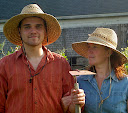Living as we do in the heart of New England, the concept of winter gardening involves greenhouses and cold frames, both of which we're keen to work with and get running this winter. In fact, a recent acquisition of four grape plants just went into the garden quite late in the season, so Sam built frames around them and mulched them to the point of live burial in anticipation of an early frost. It's been down pretty low the last few nights - 43 this morning - and in another month we can slap an old window over those newly transplanted roots and hope they'll weather the winter until they can take off in the spring. But a greenhouse is a long way off for us, and anything more than spinach might be a long shot as far as things we can eat from still-in-the-infant-stage garden this winter.
Unless the garden is in the basement.
Sam has been working hard to get our aquaponics system running in the basement in time to have plants producing for the winter. Not a small feat, but give Sam a project and he runs headlong into finishing it...and once again, succeeded. After a month of researching and watching Murray Hallam's videos to the point of memorization, and after weeks of puzzling over construction and siphon issues with his Dad, the system is working. But now, what to plant?
His parents already had some plants in four hydroponic tubes, and those found themselves hooked into the system and are already doing well, but they were already established. The strawberries I picked up at Lowe's on the clearance rack in July, which had maybe one green leaf a piece, look like this a month later:
Yes, strawberry plants blooming in a basement in September. Woot! And I'm not sure what this plant is that his mother put in there, but it certainly is taking over the works:
But the aquaponics beds - really just 3' x 4' bins filled with gravel and a constant feed of rise-and-drain nutrient-rich water - have been sadly empty for a week or more, waiting for seedlings to sprout. There's not much that's more frustrating to a gardener than a garden waiting for plants that are unwilling to hurry up and be big enough to put in.
On a trip to Blue Seal for chicken food the other day, Sam wandered into the outdoor plant section. This time of year, the highlight is the display of mums, but we're all about edible plants this year, so Sam wandered by. At the far end of the section, he found a table of dilapidated Charlie Brown tomato plants, really nothing more than leggy stems with a few miniature tomatoes trying desperately to reach maturity in a mad gasp for the next generation. He asked what the shop owner wanted for them, and she said, "Take them. They're headed for the dump." Really? Is there anything else heading for the dump? Our ears perked, we peppered her with questions about the other plants out there. She, no doubt relieved not to have a dump run in her future, loaded us up with four grapes (the aforementioned cold frame residents), eight yellow pear tomatoes, two Jerusalem artichokes, a pot of chives, and two rose bushes. I would have taken the other three roses, but we were in the golf cart with the kids and it was all we could do to fit everything in. Jackpot!
Tonight the tomatoes had the honor of being the first plants to go into an aquaponics bed:
They're leggy and spindly, and one still had its fruit (thus the noose to hold it up!), but this is fine. The idea here is that they grow up rather than out, so with luck we will be training them up around the light frame soon. The chives went into the corner of the bed, the artichokes will go into a field that will someday house pigs (they are excellent fodder) so they can spread on their own, and the roses will decorate the new chicken barn.
All in all, a winter garden with some promise.
Subscribe to:
Post Comments (Atom)





No comments:
Post a Comment